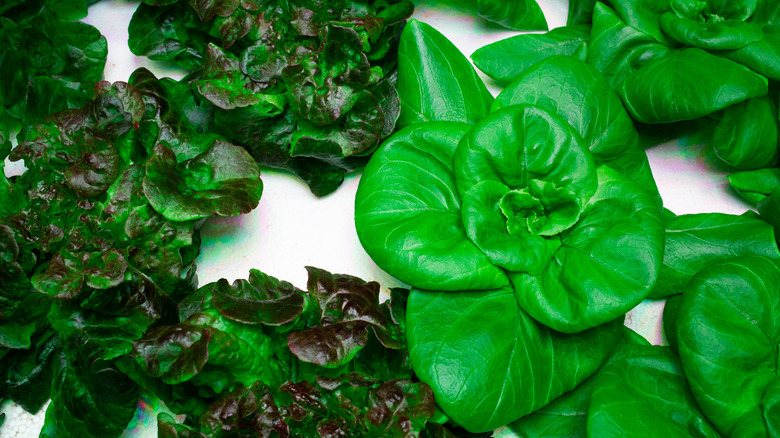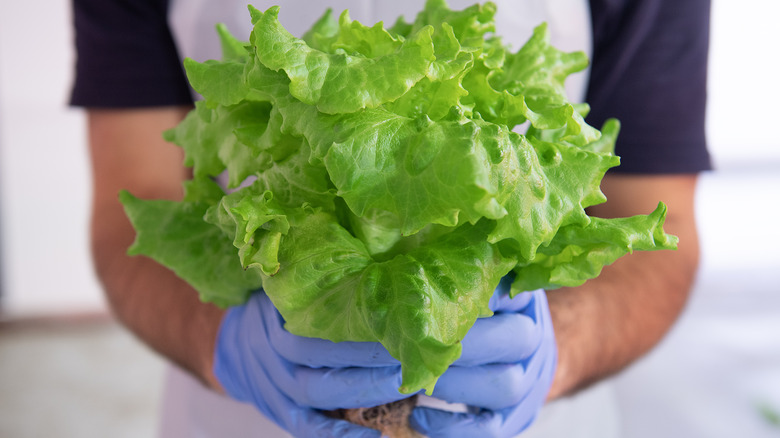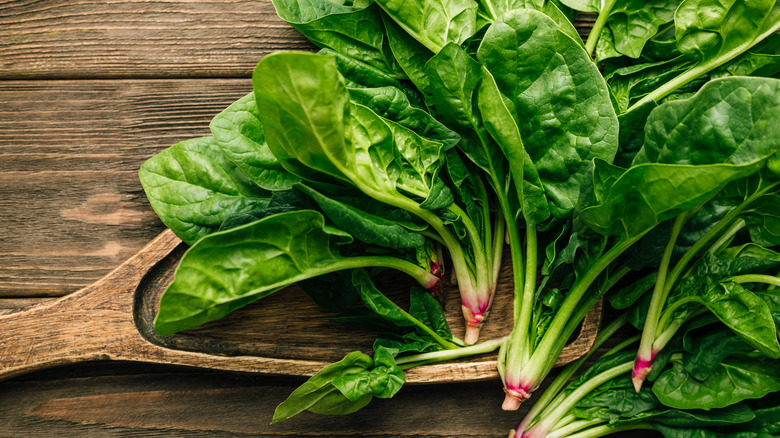A Tower Of Lettuce Is The Genius Way To Preserve Your Leafy Greens Longer
What do you think of when you read the phrase "leafy greens?" You most likely think of lettuce, cabbage, spinach, kale, and other things of that nature. You may also think of vegetables that are considered "superfoods," as leafy greens are praised by the United States Department of Agriculture for being rich in vitamins and nutrients. But one thing that you may have thought of that isn't positive is how fast those leafy greens spoil.
This isn't a joke. It seems like the moment you buy a head of lettuce or a bag of spinach, you're already throwing it out, since those greens have turned into a sickly brown. While there are many ways to keep your leafy greens fresh for as long as possible, such as sticking them in the crisper, one particular method has you creating a "tower of lettuce." Yes, a literal tower of lettuce, that keeps your lettuce, spinach, and all other leafy greens as fresh as can be.
To go about making your own tower of lettuce, all you need to do is simply cut your lettuce or chosen leafy green into smaller leaves as you normally would and then, in a tall plastic food container, stack the leaves in the container with paper towels between each leaf. If done correctly, you should have an alternating pattern of paper towels and leafy greens. But why exactly does stacking your leafy greens help to preserve them? Is there any real point to such a method?
The paper towels help absorb moisture
Leafy greens like lettuce and spinach are known for having lots of moisture, which in turn gives them that trademark crispness to them. No one wants a dried-out piece of lettuce on their burger after all. But too much moisture is the enemy of all produce, as large amounts of moisture can encourage faster spoiling.
"Any bacteria or other contamination on the greens that they may have picked up in the soil during picking and handling, etc. is going to thrive in a damp environment and that will make the greens wilt and spoil faster," says America's Test Kitchen Executive Tasting and Testing Editor Lisa McManus to Insider. The idea behind this lettuce tower not only ensures that your greens aren't being soaked in moisture, but they're also being separated from each other, preventing any bruising or damage that happens when leafy greens are stuffed together.
It's important to note, however, that you'll want to change the paper towels inside of your lettuce tower every so often. While the paper towels do absorb a large amount of excess moisture from the vegetables, letting said greens sit on top of the damp paper towels for days on end may not end up faring so well. Swap out the paper towels for fresh dry ones every few days to prevent any bacteria or wilting from occurring.
You can also roll the greens in paper towels
If you don't have much space for a tower of lettuce in your fridge, you needn't worry. The main focus of this method of storage is ensuring that as much excess moisture as possible is absorbed away from the delicate greens. Even if you can't stack your lettuce or spinach like a Jenga tower, you'll still be able to get the same results just by "rolling" the green leaves in paper towels.
The process of rolling your greens in paper towels is incredibly simple. First, take the greens of your choice and lay them out on a paper towel following the prerequisite rinsing. Once the greens are dried, gently roll each leaf or piece in the paper towel, similar to how you would roll lettuce up in a wrap. When all leaves are rolled up, place each paper towel roll into a large resealable plastic or sandwich bag before placing the entire bag into the crisper of your fridge. This way, if you need lettuce or spinach for a recipe, you simply open the bag, take out as many rolls as you need, and then put the bag back in.
Of course, you'll still need to replace each paper towel every so often as to prevent the paper towels from falling apart. Whether or not you stack or roll your greens, however, you'll be glad to have fresher, crisper greens for your recipes.


